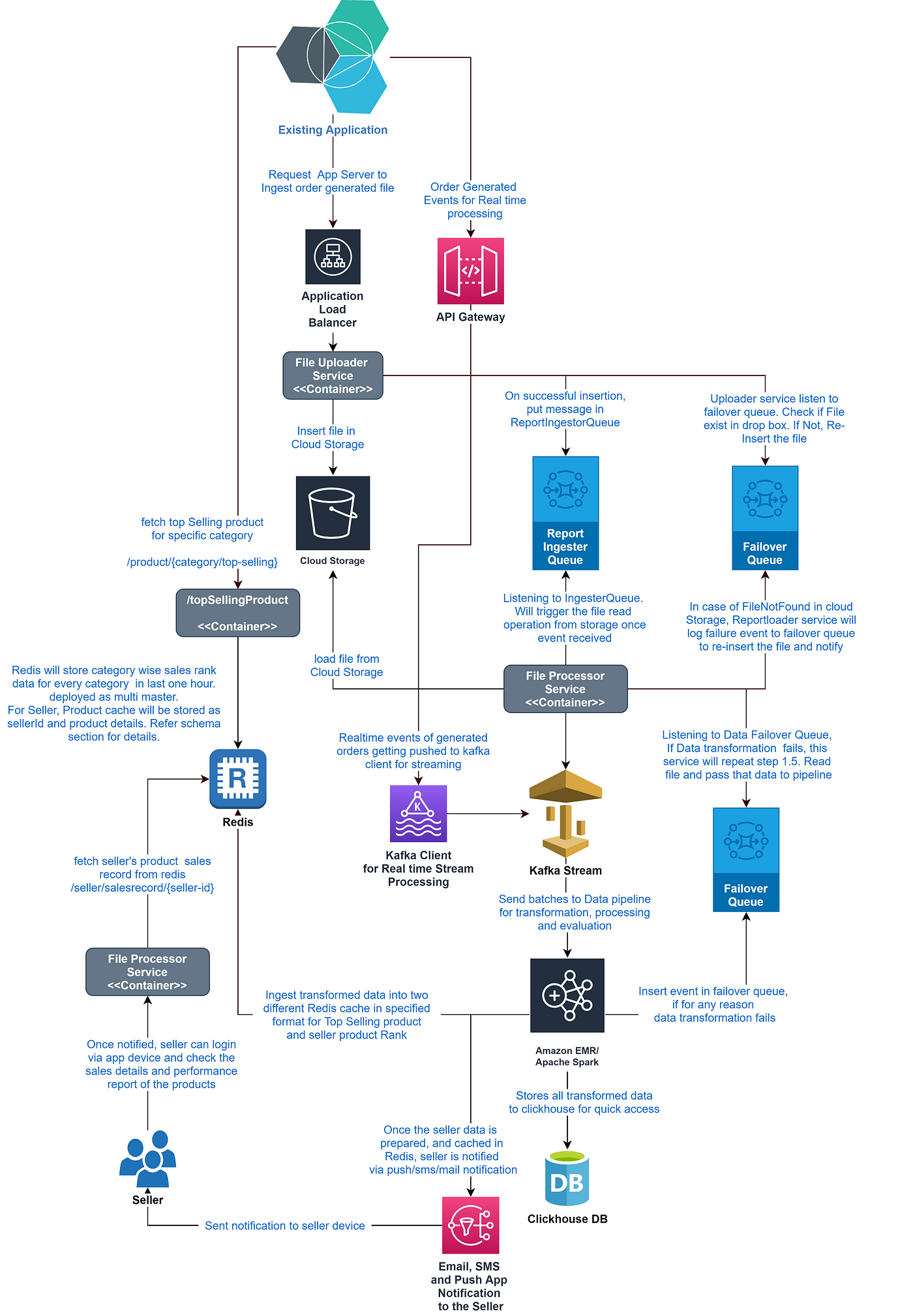Design E-commerce app to display Top Selling Products, daily sales report and seller’s sale Performance
 Ravinder Singh
Ravinder SinghExtending an e-commerce platform to showcase top-selling products, generate daily sales reports, and evaluate seller performance is a strategic move to enhance user engagement and provide valuable insights to stakeholders. In this blog, we'll delve into the key areas to address, design decisions to consider, and the API and schema designs necessary for this integration.
Scope of Enhancement
To successfully implement these features, the following objectives should be addressed:
Display Top-Selling Products: Integrate a feature that showcases the top-selling products within the category a user is currently exploring. This requires creating a new API endpoint capable of handling over a billion requests daily to support high traffic volumes.
Daily Sales Reporting: Develop a system that generates daily sales reports in a specified format, storing them in a repository accessible to relevant teams for analysis.
Seller Performance Integration: Enhance the platform to inform sellers about their product sales rankings periodically, fostering transparency and encouraging performance improvements.
Hourly Data Updates: Ensure that the top product results are updated every hour to provide users with the most current information.
Flexible Data Ingestion: Support both batch (e.g., hourly, 15-minute intervals) and real-time data ingestion methods to accommodate various data processing needs.
Scalability and Data Integrity: Design the system to be scalable, capable of handling increased loads during peak or sale hours, and ensure no data loss occurs.
Seller Notifications: Implement a notification system that alerts sellers about new reports via email, SMS, and app-based notifications, with options for batch or real-time delivery.
System Design

Design Decisions
To meet the above objectives, several design choices are crucial:
Data Storage with Redis: Utilize Redis for ingesting top-selling product data and seller product sales rank data. Redis's hash-based key-value storage is ideal for caching, with the Category ID serving as the key and related data as the value. Deploying a Redis farm with a multiple master setup ensures high availability and supports response times under 200 ms during high TPS loads.
Notification System Using AWS Services: Employ Amazon Simple Email Service (SES) for email notifications and build a centralized notification application using AWS managed services like Simple Queue Service (SQS), Simple Notification Service (SNS), and AWS Lambda. This setup facilitates efficient and scalable notification delivery.
Data Transformation Pipelines: Implement data transformation pipelines using Apache Spark or Apache Beam. These pipelines will parse, compare, and process incoming data files, transforming them into actionable insights for top-selling products and seller performance metrics.
Messaging and Streaming Integration: Incorporate messaging and streaming systems to facilitate inter-component communication and prevent data loss. This ensures reliable data flow between different parts of the system.
Data Retention Strategy: Assume that only the latest data needs to be ingested, with Redis data being replaced for each key (Category ID or Seller ID) every hour. If historical data retention is required, the job pipeline should retrieve existing data from Redis and merge it with the latest records.
API(s), Schema, and Schema Design
Designing robust APIs and schemas is essential for seamless integration and data consistency.
APIs
Top-Selling Products API:
Endpoint:
GET /api/top-selling-products/{categoryId}Description: Retrieves a list of top-selling products for a specified category.
Parameters:
categoryId(path parameter): Unique identifier for the product category.limit(query parameter, optional): Number of top products to return (default is 10).
Response:
Status: 200 OK
Body: JSON array of top-selling products, each containing product ID, name, sales count, and rank.
Daily Sales Report API:
Endpoint:
POST /api/sales-reports/generateDescription: Triggers the generation of the daily sales report.
Response:
Status: 202 Accepted
Body: JSON object with report ID and status.
Seller Performance API:
Endpoint:
GET /api/seller-performance/{sellerId}Description: Retrieves sales performance data for a specific seller.
Parameters:
sellerId(path parameter): Unique identifier for the seller.
Response:
Status: 200 OK
Body: JSON object containing seller's sales rank, total sales, and performance metrics.
Schema Design
Top-Selling Products Schema (Redis):
Key:
category:{categoryId}:top-productsValue: JSON array of objects, each representing a product with fields for product ID, name, sales count, and rank.
Sales Report Schema (Storage):
Fields:
reportId: Unique identifier for the report.generatedAt: Timestamp of report generation.reportData: Link or reference to the report file stored in the repository.
Seller Performance Schema (Redis):
Key:
seller:{sellerId}:performanceValue: JSON object containing fields for sales rank, total sales, and other performance metrics.
By thoughtfully addressing these areas, the e-commerce platform can effectively display top-selling products, generate insightful sales reports, and provide sellers with performance feedback, ultimately enhancing the overall user and seller experience.
Subscribe to my newsletter
Read articles from Ravinder Singh directly inside your inbox. Subscribe to the newsletter, and don't miss out.
Written by

Ravinder Singh
Ravinder Singh
Senior Architect with 15 years of experience in development, Design, Analysis, and Implementation of large-scale distributed systems using Java, micro services, open source, messaging, streaming and cloud technologies. Experience in Core technology and deployment strategy, System Design, Architecture and Technology Consulting for various transformation, migration or Greenfield projects.